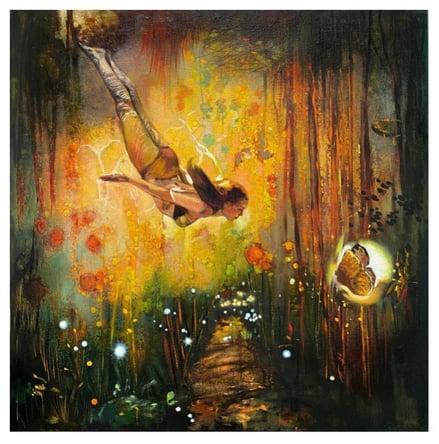
Photo caption: The Surrealist movement of the 20th century still inspired modern painters, like Elli Milan, today. Photo courtesy of the Milan Art Institute.
As an artist, you’re a warrior for culture and change. The catalyst for new ideas is inside you and takes its energies from the movement of life all around you. But in order to pioneer new ideas, we must first know the movements of the past.
Surrealism. It was an art movement so distinct that even if you do not know the names of some of its most famous artists, you surely know their works. After all, who can forget Salvador Dali’s melting clocks or Rene Magritte’s pipe that isn’t a pipe?
Despite the original movement only lasting a relatively short amount of time, the Surrealist movement left a lasting impact on the art world that survives to this day.
This blog post is the first of two that take a look at the Surrealist movement, its artists, its beginnings and where the movement is today. The post is based on a talk about art history, given by Elli and Dimitra Milan, on the Art Club social learning platform.
Who Started the Surrealist Movement?
Given the prevalence of paintings like Dali’s The Persistence of Memory, it would perhaps be a natural assumption that the Surrealist movement started with painters. However, that is not the case.
According to Artsy.net, poet Andre Breton founded Surrealism in 1924 (officially) in the city of Paris, though there is some belief that the murmurings of the movement began as early as 1917. The work of painter Giorgio de Chirico is said to have inspired Breton.
In 1924, Breton published his piece The First Manifesto of Surrealism. In this document, he tried to define Surrealism.
Video captions: Surrealism in 5 Minutes: Idea Behind the Art Movement
What Inspired the Surrealists?
The Dada movement played a big role in the formation of Surrealism. The Surrealist movement pressed against the ideas that were introduced by the Enlightenment.
That is to say, that Surrealists rejected the ideas of individualism and reason, favoring the more dreamlike irrational qualities of the subconscious mind. Many Surrealists took their cues from the work of Sigmund Freud and his writings on dreams.
Surrealists who followed this route tried to paint their dreams as a way to access their subconscious. They believed that the subconscious mind was the source of all human creativity. They strove to free the mind in their work.
Still others embraced the idea of automatism, according to Milan Art Institute founder Elli Milan. Automatism saw Surrealists looking to a series of images to create inspiration. This type of inspiration relied on the free association of the images. Collage is an excellent example of how they combined different images together, according to the Tate.
What Are Some of the Characteristics of Surrealism?
Surrealism can be difficult to define, though there are a few types of visual elements that often make their way into a Surrealist painting, according to Dimitra Milan, MAI co-founder.
In a Surrealist painting, it isn’t unusual to see:
Exaggerated scale: Things can be too big or too small for the context.
“Odd” image juxtapositioning: Good examples of this might be Dali’s melting clocks, Magritte’s mermaid with the head of a fish and the body of a woman or women with a bouquet of flowers where their heads should be.
Dreamlike images: Since Surrealist art is supposed to reveal the subconscious, the imagery in Surrealist art often has a dreamlike quality.
Final Words on the Surrealist Movement
The Surrealist movement counts among the most important art movements of all time. It introduced art lovers to the idea that the subconscious mind can be a source of inspiration and art. It also introduced the world to artists, like Rene Magritte, Salvador Dali and Frida Kahlo. Many of the most inspiring culture warriors of today have been inspired by the Surrealists.
If You’d Like to Learn More About Art History, Read On!
3 Da Vinci Drawing Tools You Might Not Know About
Caravaggio: Lighting a Dark World
The Top 5 Reasons Why You Should Study Art History

